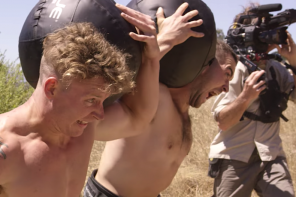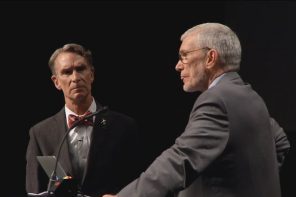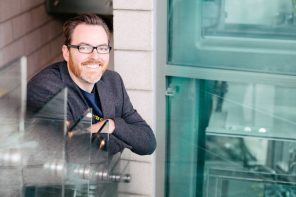Thirty years ago, S. Boyd Eaton laid out the foundation for the Paleo diet in a brief article for The New England Journal of Medicine, which he co-authored with the anthropologist Melvin Konner.
Eaton and Konner’s argument was seductively simple: our bodies evolved to eat one diet, while industrial civilization gave us another. If you return to the old diet—more meat and vegetables; less grain and dairy—you’ll regain the vigor of preagricultural hunters and gatherers.
Today, Paleo is one of the most influential dietary trends in the country, with as many as three million followers and a disproportionate cultural influence. And while it’s easy to mock Paleo as the retrograde fantasy of Patagonia-jacketed professionals who buy fifty-dollar grass-fed steaks and imagine themselves loping across a Paleolithic savannah as they strain through a CrossFit workout, the lifestyle does capture a certain discontent with modernity.
So when I saw Eaton speak at a nutrition conference this past November, I expected him to talk a lot about the past. Instead, Eaton, a radiologist, focused on the future—specifically, a future world in which everyone can embrace Paleo principles.
On further reflection, this makes sense. Like any popular diet, Paleo is as much a theory of human flourishing as it is a prescription for healthy eating. Yet, as theories of human flourishing go, Paleo is an ethical wreck. There’s basically no way for seven billion people to eat that much meat—let alone live out a full-on Paleolithic-biosphere-restorationist life—on a planet this crowded and short of resources.
Eaton recognizes that conundrum. One possible solution is to reject certain elements of the diet, or to limit it to an elite, high-consuming sliver of the global population.
Or, you could cut the world’s population by a factor of 70. That’s Eaton’s preferred solution: gradual population reduction, through a lowered birthrate, until we arrive at a global population of 100 million, and return to a world where it’s possible to live out what he calls “true Paleo.” Such a world wouldn’t just be better for human carnivores. Considering humanity’s impact on the environment, Eaton argues, it would also be better for the planet.
This is Paleo eschatology, essentially—a vision of the world’s final destination, rendered in the language of an idyllic past. Eaton’s vision did not go over especially well with the other participants in the nutrition conference, most of whom were advocates of vegetarian diets, and most of whom seemed hesitant to suggest reducing the world population by a few billion folks in order to support their respective concepts of human and planetary well-being. “You’re saying that eating meat is sustainable if we reduce the world’s population by orders of magnitude?” asked Dean Ornish, the diet guru who helped turn Bill Clinton into a vegan. “That’s hardly a compelling argument for eating meat.”
“You’re saying that eating meat is sustainable if we reduce the world’s population by orders of magnitude?” asked Dean Ornish, the diet guru who helped turn Bill Clinton into a vegan. “That’s hardly a compelling argument for eating meat.”
“Maybe for you,” Eaton replied.
A few days later, I visited Eaton at his home in Buckhead, an upscale neighborhood in Atlanta. Thoughtful and spry at age 77, he approaches everything from economics to sleeping patterns through the Paleo lens. Over coffee, Eaton talked with The Cubit about Jean-Jacques Rousseau, the Left Behind series, and why Paleo dieters should stop eating so much meat.
This interview has been edited for clarity and length
How did you come to think about nutrition in terms of the past?
Well, I’ve always been very interested in paleontology, anthropology, history, those kinds of things. And when I was about to turn 40, I became interested in health promotion and disease prevention from a personal standpoint.
As I read recommendations regarding health promotion and good healthy forms of living, it occurred to me that we were in fact reinventing the wheel. All these recommendations and so forth seem to be reiterations of how people were living before agriculture. And then it occurred to me that our genetics have changed very little since then. The basic fundamental processes of our biology are conserved, particularly our metabolism and therefore our nutritional needs.
Did you realize that the idea was going to take off? You published this short article in the New England Journal of Medicine—
That article received a terrific amount of attention at the time. But I had no interest in becoming an entrepreneurial person or anything of that sort. But Loren Cordain, who is a good friend of mine, went into it from a more… I wouldn’t say entrepreneurial, but toward that end of the spectrum… and lots of other people jumped on board.
Do you worry that people just ate really unhealthily back in the day?
Of course not. However they ate is how our bodies adapted themselves.
The Paleo conversation usually comes back to diet. But you’ve focused on other parts of Stone Age life, too.
That’s one issue I have with the current Paleo movement. You can really use components of our ancestral lifestyle as models for what should be going on today, if you wish to live healthfully.
There’s diet, but also sleep, exercise—
There’s women’s reproductive experience. If you take the reproductive experience of women in the Stone Age, and compare it with the reproductive experience today—particularly of highly educated career-oriented women—there are terrific differences in the number of children, the age at menarche, the age at first full-term pregnancy, nursing patterns—those kinds of things are all very different from what they were before. And in each case, the way we live now is a risk factor for breast cancer and, to a lesser extent, for ovarian and uterine cancers.
The risk factor for cancer goes up slightly. But other things seem to be a whole lot better—
Oh, I quite agree. I’ve got four granddaughters, and I certainly don’t want them having their first full-term pregnancy at age 19, which was the situation for hunters and gatherers.
In the past few years, the Paleo diet has boomed. Are you surprised? What does Paleo look like to you now?
Well, I guess in the end I’m pleased, because it gets a lot of people thinking about their health. I’m very happy for friends of mine, Loren Cordain particularly. They feel themselves to be successful, and I think they’re basically doing good for the world.
I myself have always been more interested in it in an ideological or academic way. I want to find out more and more about how people lived and how that relates to how we live now. To me it’s an intellectual exercise.
It does seem to fit into these other intellectual currents, going back to the story of the Garden of Eden. What do we lose when we leave a lifestyle behind? What do we lose when things change suddenly?
Hm. What do you think about that?
Think about what?
Are we better off psychologically, or worse?
When things change really quickly? I think it’s very easy to glorify the past.
No question about that.
There are critics who look at Paleo trends and say they’re glorifying the past. I think that’s justified, in some cases.
That goes all the way back to Rousseau, long before there was any Paleo movement…there are some aspects about that period that were very—the sort of thing that we could be very pleased about. But there were some things that weren’t very good about it, too. I mean, the infant mortality rate was very high. And that was the case, really, up until about the late 1700s or early 1800s.
And then industrialization happens. Now the question becomes, which parts of the past are we going to pull into the present, and which ones will we leave behind?
I think that many of our physical, metabolic aspects are controlled by genes which really haven’t changed substantially since agriculture. And I feel that many other of our behavioral characteristics are currently out of sync with the standards, the categorical expectations, that come from the past.
The idea of socioeconomic inequality now is totally out of kilter with what was going on in the past. There were no rich, there were no poor; everybody had more or less the same material possessions. And the hunters and gatherers worked very hard to keep down any sense of one person being able to boss anyone else.
There were no dominance hierarchies?
Well, they were much more subtle than what we have now. There were not the unforgivable discrepancies that we have now.
Do you know what the Gini coefficient is?
No.
It’s a scale from 0 to 1. At 1, one single person in the society owns everything. At zero, everybody is absolutely equal. In the United States, we’re around 0.4, 0.45, something like that. Ever since agriculture [the number has] gone up. But before that it was close to zero. We are oriented toward equality. But we don’t have it.
We could frame this in terms of past and present. But we could also look at it in terms of scales: smaller social groups can be more equal. When things get big, certain hierarchical structures emerge, and inequalities arrive.
Well, I think that’s absolutely so. If someone were trying to take the best from the past and put it together with the best from the present, you couldn’t say that we’re all going to be absolutely equal socioeconomically. But we could arrange a tax mechanism that meant the greatest discrepancy was tenfold or twentyfold or twenty-five fold, and you had a standard baseline, and then the wealthiest people with the highest net worth would be 10, 15, 25 times—whatever the economist figured out was best, not the thousand-fold or ten thousand-fold difference that we have now.
We have to look at the past, and especially the hunter-gatherer past, through such a tiny peephole. There are just a few hunter-gatherer societies that have managed to survive on the fringes, and not much more.
Exactly. They are poor surrogates for Stone Agers, but they’re the best available.
So do you feel like—if we were right now to be transported back 50,000 years, do you think we’d have a really good sense of what we’d find?
We certainly don’t have a full picture of what was going on then. If you could be a person going back into the past with your little camera, and your audio, and you could understand what people were saying, I’m sure we’d learn a great deal that we are surmising about now. Surmising correctly or incorrectly.
This image of past social structures—the small bands—how well supported do you feel like that is?
Very.
Okay. Because of—
The only places where there were larger aggregations of people who were hunters and gatherers were in unusual circumstances where the food supply was very, very abundant. Typically, for example, along rivers, where there were extensive fish runs, you could find aggregates of 200 or 300 people rather than the small bands of 20-50, perhaps.
Can we talk about the future?
Sure.
We don’t live in tiny bands. We live in huge societies. So where do you go next? If you see this better way of living in the past, what’s the solution for the future?
I’m in favor of population reduction—not by virtue of killing people or by having another plague or something like that, but rather by having one child per family, voluntarily, not as an obligatory governmental proclamation. You have to think in long terms. In 200 years, we could be down to 100 million people for the whole population of the earth.
If we keep on going like we are, in 200 years, we’re going to have 10 billion people, or maybe some more than that, 12 billion people. You could imagine that the individuals living that way can survive—if we adapt. But it would be survival, it would be an existence; whereas, if we’re down to a hundred million, each person could flourish.
If you have 10 billion or 12 billion or whatever the final number [of people] would be, then the rest of the biome is going down the tubes, in my opinion. If we go back down to a hundred million, which is ten times [the population] at the beginning of agriculture, then the rest of the biome can begin to flourish again as the humans flourish.
You have to modify reproductive experience to keep it at a steady plane. If we’re going to modify reproductive experience, let’s go with a trend that’s already underway, which is to have fewer and fewer children per family.
I think the optimal level is one that would afford a lifestyle similar to what middle class Americans have now for everybody on earth. At that point, we could live as flagrantly, as profligately, as we might wish—not that I’d recommend that, but we could—because there’d be so relatively few of us compared to the number we have now.
I’m trying to imagine what it would be like to be born on that planet: 200 years in the future. Only 100 million people.
Well, I think it could be a wonderful life. You would have a lot of material goods. You could have cities, you could have towns, you could have outposts. But you’d have large areas of the world that were basically uninhabited by humans, where animals, the biome, could regenerate to a certain extent.
Is it really better to have 100 million people flourishing than 10 billion living an okay life?
Well, that’s the greatest good for the greatest number—the argument that you’re making. If you want a livable lifestyle for the greatest number, then living at a minimal level with 12 billion people would be better. If you want people living the very best possible lifestyle, then 100 million people would be better. If you stop thinking about only human beings, but thinking about all the rest of the living organisms on earth, clearly the 100 million people is far better for the rest of the organisms on earth than is the 12 billion.
How Paleo will the lifestyle of those 100 million people be?
Well, I don’t think we’d change our clothing, our lifestyle, hardly at all. I’d like to think that we’d maintain the best of the past, and merge it with the best of the present.
More steak, but still antibiotics.
I really think there is a module in our brains, a neurological assembly, that says steak is really good, or meat is really good for us. I mean, it is the best kind of thing to eat.
We have mental constructs about what is an attractive woman or what is an attractive man, for mating purposes. We have mental constructs about all sorts of things. If you are walking out onto a beautiful bucolic scene or prairie, a beautiful countryside, you think, “This is great.” If you’re walking down into a darkened alleyway, and you perceive up ahead of you a menacing looking person, your mind is saying “This is not a good situation,” whether anything bad happens to you or not. We have these built in expectations.
I think our genes and our cultures are more flexible than that. I’m skeptical—
I don’t think our genes are that flexible. But obviously our culture, everything we do is an interaction between our genetic makeup and the way we live.
I’m wondering about the future again. What is going to look like? It’s kind of a scary thought to me, I guess, all those people disappearing.
Well, it’s not like this puts—isn’t there a series of books called The Disappeared, or something?
The Left Behind series?
The Left Behind series. It wouldn’t be like that. No matter what we do, we’re going to go up to 10 billion [people]. But if at that point we began to come back down again, it would be over several generations, and there would be enough time that you would become adjusted to the difference.
Our political visions are always about growth, though.
Economics.
Good point: our economic visions are always about growth. Actually, our political visions are often about returning to some version of the past. And those two narratives don’t always click.
Intellectual, scientific growth can go on forever. But material growth, in the sense of greater and greater productivity, more and more use of our natural resources, more and more pollution going out all over the world—that’s a no no. That clearly has got to stop.
Also on The Cubit: Mammoths, passenger pigeons, and the future of the past





